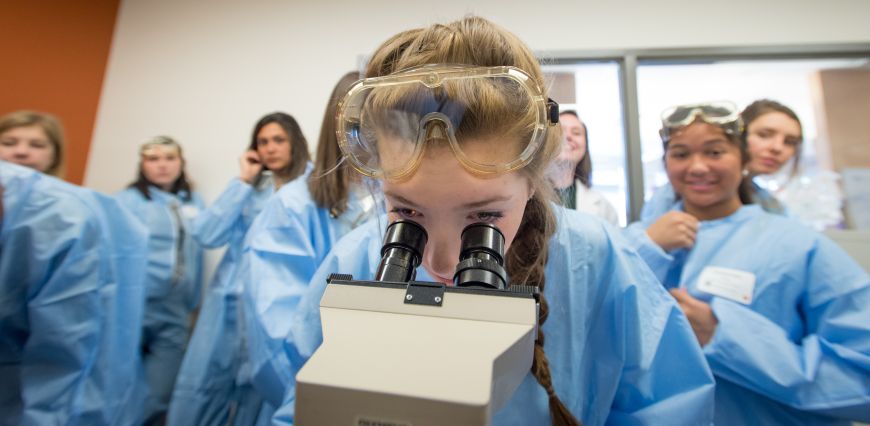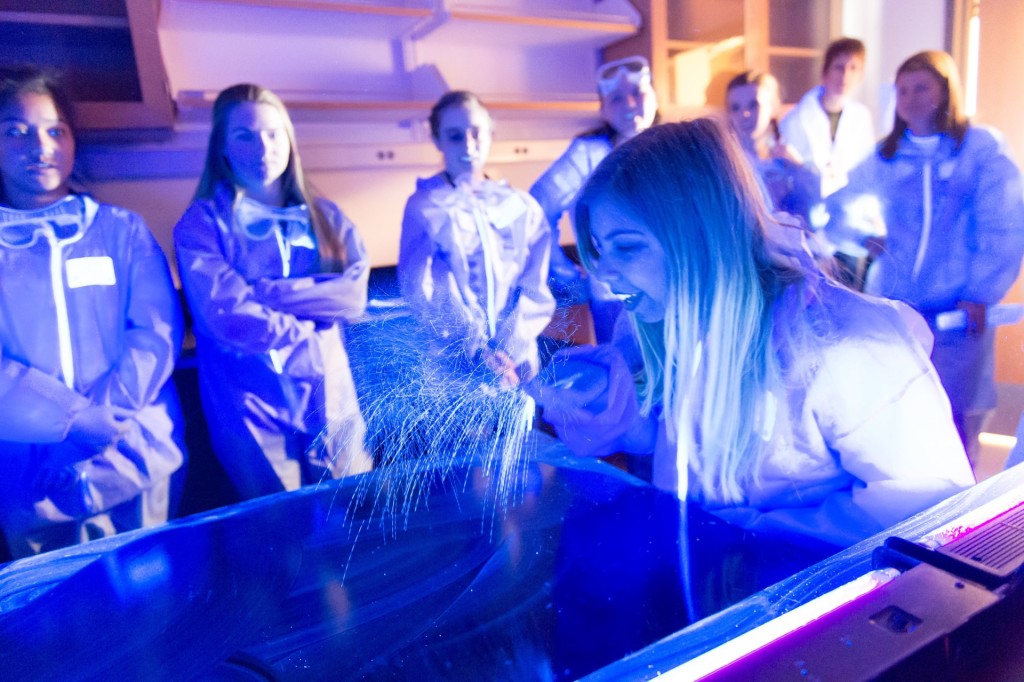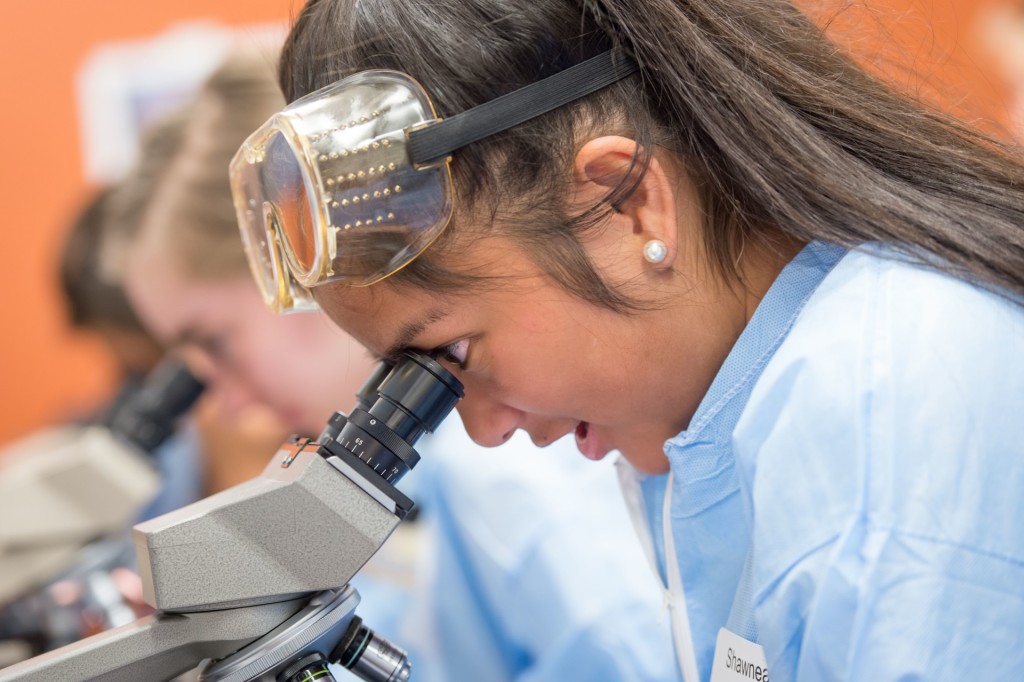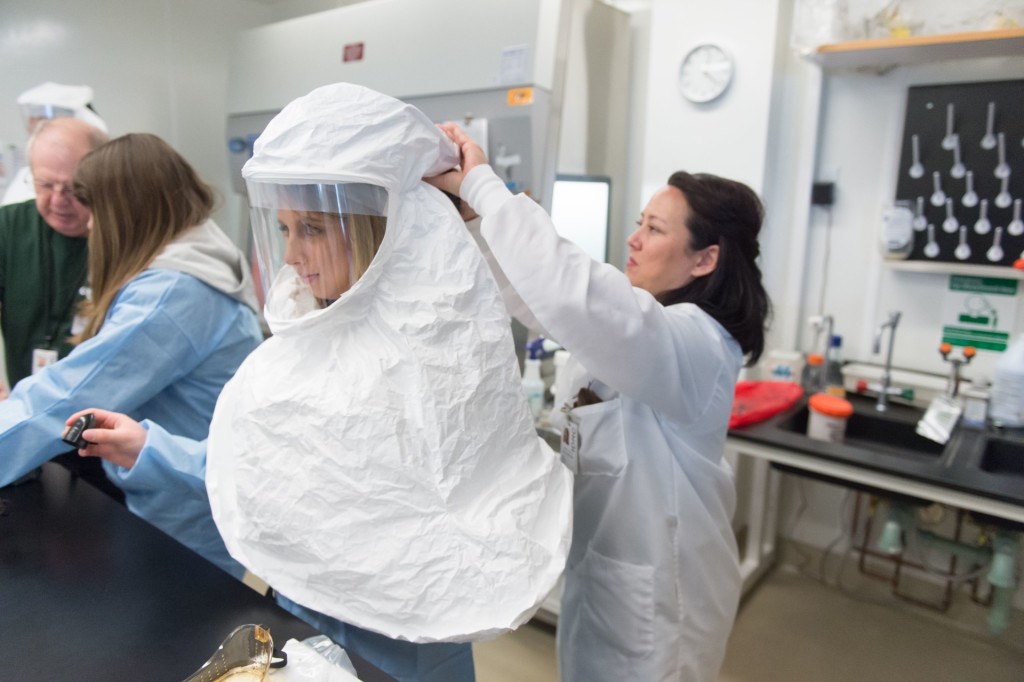
Shawnea Pagat, a senior at Fossil Ridge High School, sprinkled a tiny spoonful of Glo Germ powder into her palm and prepared to cough like a tuberculosis patient.

In a dark laboratory crowded with teenagers, Pagat then expelled two short, forceful bursts of air. Her cough spewed the specially formulated powder across a black tabletop illuminated by ultraviolet light, demonstrating the ease of spreading infectious disease.
“Alright!” cheered Angelo Izzo, the Colorado State TB researcher who hosted the exercise. “We’ve found patient zero.”
The simulation was one of 10 hands-on activities offered March 24 by the CSU Mycobacteria Research Laboratories for about 80 students from science classes at Fort Collins high schools. The students visited labs on the Foothills Campus to mark World TB Day, which annually raises awareness about the infectious lung disease tuberculosis and its devastating global impact.
Visiting students got a lab-level look at cutting-edge research to better understand, detect, prevent and cure TB. The respiratory disease, caused by Mycobacterium tuberculosis, kills some 1.5 million people each year, mainly in developing countries. One-third of the world’s population is infected, according to the World Health Organization.
That alarming rate of infection, caused by airborne pathogens, didn’t surprise high-schoolers after the Izzo Lab’s demonstration.
“It shows how infectious TB can be, which is pretty crazy,” said Pagat, who was so amazed that she took two turns with the Glo Germ powder. “You don’t think of getting TB just walking through air.”
Chase Gulau, a junior at Polaris Expeditionary Learning School, was surprised at “how deadly and very contagious tuberculosis is. I had no idea it was such a problem.”
Bailyn Furrow, a junior at Rocky, enjoyed the hands-on labs. “I thought it was going to be just lectures, so I liked that we got to actually do things.”
Real-world research

During other rotations, the high-schoolers learned about laboratory methods used to identify bacteria and their potential drug vulnerabilities; examined infected lung tissue by microscope; and heard about pre-clinical drug tests. They used pipettes, stains, gels – and tried on the personal protective equipment required for research in Biosafety Level 3 laboratories, the sealed spaces used for work with highly infectious pathogens.
“I thought it was interesting that they have a whole room to demonstrate how the scientists are trained,” said Ethan Morrison, a freshman at Fort Collins High School, after donning the protective hood and jumpsuit for the BSL3 lab. “I’m thinking of going into biomedical science, so that was really interesting for me.”
“We got to see what the real world of science is like. We learn in labs but it doesn’t always translate,” said Justin Allen, a senior at Rocky Mountain High School who plans to study “something with chemistry” in college.
“It was a really cool experience to see all the possibilities to study within the same disease,” said Lars Worlund, a Fossil Ridge sophomore who plans to enter a pre-med program.
“It was interesting to learn how many different branches of science there are,” said Chelsea Chavira, a student at Poudre High School.

As he watched his granddaughter Amanda tour the lab where he built his career, professor and biosafety officer Bob Ellis marveled at the crowds of young people interested in science. “It was really great to see that many students learning what research is really like,” he said.
“We are really pleased to host so many rising scientists from local schools and hope they leave with a sense of the high-level research conducted in our Mycobacteria Research Laboratories,” said Karen Dobos, a TB investigator and lead organizer of this year’s World TB Day activities at CSU. “We also hope the students have a better understanding of microbiology and its application to halting infectious disease.”
Rocky Mountain High School teacher Carol Seemueller has been teaching biology and anatomy/physiology for 26 years, and was impressed with “how many opportunities there are and how many questions there are to ask in research.”
World TB Day
The global event marks Dr. Robert Koch’s discovery of Mycobacterium tuberculosis as the cause of TB on March 24, 1882. Koch was a German physician known as the founder of modern bacteriology; he won a Nobel Prize for his work.
Mycobacteria Research Laboratories
The MRL, in the College of Veterinary Medicine and Biomedical Sciences, comprises more than 150 scientific investigators, staff and students working on innovations to diagnose, prevent, and treat tuberculosis and related diseases. They compose the largest group of university researchers in the world focused entirely on this category of infectious disease.
Why Colorado?
Our state has historical ties to TB: In the early 1900s, Colorado was called the “World’s Sanatorium” because TB patients came here in droves, seeking remedy from sunshine and clean, dry air. The CSU veterinary program, founded in 1907, focused on eradicating tuberculosis from dairy cattle because infected animals can transmit TB to people through raw, unpasteurized milk.
Ashley Manweiler and Kristen Browning-Blas contributed to this report.